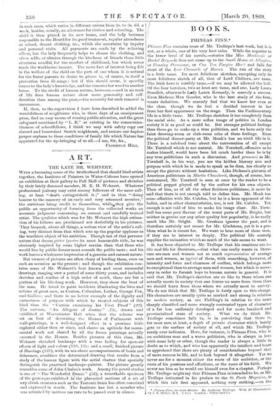ART.
---4— THE LATE MR. WEIINERT.
WITH a becoming sense of the brotherhood that should bind artists together, the Institute of Painters in Water-Colours have opened an exhibition at their gallery in Pall Mall of pictures and sketches by their lately deceased member, M. E. 11. Wehnert. Whatever professional jealousy may exist among followers of the same calling, at least " death extinguished' it ;" and in thus " doing honour to the memory of an early and very esteemed member," the survivors bring credit to themselves, whileothey give the public an opportunity of forming from the collec ted works an accurate judgment concerning an earnest and carefully trained artist. The qualities which won for Mr. Wehnert the high estimation of his fellows are proclaimed not doubtfully in his pictures. They bespeak, above all things, a serious view of the artist's calling, very distinct from that which sets up the popular applause as the worthiest object of his ambition. Though not of that perverse nature that deems pictor ignotwm its most honourable title, he was obviously inspired by some higher maxim than that those who would live by public favour must consult the public taste ; and his work leaves a wholesome impression of a genuine and earnest nature.
But owners of pictures are often chary of lending them, even on such an occasion as the present ; and though the exhibition contains some of Mr. Wehnert's best known and most successful drawings, ranging over a period of some thirty years, and includes sketches and studies of a high order of merit, these are but a portiou of his life-long work. However, they show the bent of the man. He loved to paint incidents illustrating the lives and actions of great men, as Caxton, Columbus, Luther, George Fox, and Galileo ; and there is no better example of the dignity and earnestness of purpose with which he treated subjects of this kind than the " Caxton examining his First Proof" (29). The cartoon, " An Allegory of Justice (73), drawn and exhibited at Westminster Hall when first the scheme was set on foot of decorating the Houses of Parliament with wall-paintings, is a well-designed effort in a province little explored either then or since, and shows an aptitude for monumental work not shared by all the fresco paintings actually executed in the Houses. Besides pictures of this class, Mr. Wehnert sketched landscape with a true feeling for open-air effects of light and colour (110, 13); and a small, finished picture of Hastings (131), with its sea-shore accompaniments of boats and fishermen, combines the determined drawing that results from a study of the human figure with the aerial charms that specially distinguish the practised landscape-painter. The picture greatly resembles some of John Chalon's work. Among the pencil studies is one of "The Wonderful Dance" (52), a remarkable specimen of the grotesque exhibited in the phrenzied motions of a set of wry elvish creatures such as the Teutonic brain has often conceived and expressed in words. The Institute has lost a member who was actuated by motives too rare to be passed over in silence.


































 Previous page
Previous page